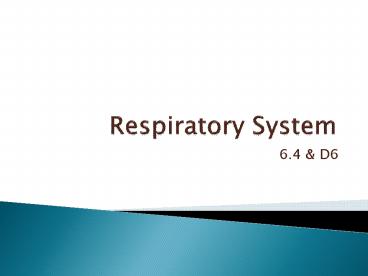Respiratory System - PowerPoint PPT Presentation
Title:
Respiratory System
Description:
Title: Respiratory System Author: De Souza, Monica (Michael Power/St Joseph) Last modified by: TCDSB Created Date: 8/16/2006 12:00:00 AM Document presentation format – PowerPoint PPT presentation
Number of Views:47
Avg rating:3.0/5.0
Title: Respiratory System
1
Respiratory System
- 6.4 D6
2
Partial Pressure
- Partial pressure the pressure exerted by each
component in a mixture. - The pressure of a gas in a mixture is the same as
the pressure it would exert in the same volume
and temperature alone.
3
Oxygen Dissociation Curves
- Oxygen binds to hemoglobin of erythrocytes.
- (oxyhemoglobin HbO2)
- Each hemoglobin can bind a maximum of 4 molecules
of oxygen (1 for each heme group) - If the maximum number of oxygen molecules have
attached, the hemoglobin is fully saturated.
4
(No Transcript)
5
When the pO2 is 100mmHg, the HbO2 is 100 (That
means there are 4 O2 bonded to each hemoglobin
molecule. See Fig 1, page 700
6
- The amount of saturation of hemoglobin depends on
the concentration of oxygen in the air - pO2 depends on the concentration of oxygen in the
air and the air pressure. - If O2 decreases, the pO2 decreases
- If air pressure decreases, pO2 decreases
7
Oxygen Dissociation Curve
- The pO2 in the lungs is high (100mm Hg), which
encourages hemoglobin to become saturated with
pO2. - The pO2 in the muscles is low (20 mm Hg) which
encourages pO2 to dissociate from hemoglobin and
enter the cells where they are needed.
8
High Altitudes
- At higher altitudes, the air pressure decreases,
and so does the pO2. - The means that the saturation of hemoglobin is
lower - i.e. less oxygen bonded to hemoglobin and
therefore less oxygen transported by the rbcs
9
- The reduced air pressure also reduces the rate of
diffusion of gases across the respiratory
membrane - As a result, less oxygen is available for the
body cells - This can cause altitude sickness
- SYMPTOMS shortness of breath, headaches,
dizziness, tiredness, nausea, alkalemia (high
blood pH)
10
- Your body will adjust after a few days.
- Increase ventilation rate (shallower, more
frequent breaths - The kidneys will excrete akaline urine (blood
remains acidic, continues increased ventilation
rate) - Over time, when O2 supply is reduced, the body
will secrete the hormone erythropoietin (EPO)
which will increases the number of red blood
cells in the body.
11
- An increase in rbc, means and increase in O2
absorption, which means more O2 for the body
cells. - People who permanently live at high altitues will
also have a greater lung surface area and larger
vital capacity than those living at sea level.
12
Altitude and Athletic Training
- Endurance athletes (long-distance runners and
triathletes) often train at high altitudes for a
few weeks to increase their rbc so they have more
O2 and therefore more ATP energy for their event
13
Sea Level
- At sea level, air pressure is 760 mm Hg
- 21 oxygen
- pO2 0.21 x 760 159 mm Hg
- pO2 of air in the alveoli is 100 mm Hg
- Because water vapour added, and
- pO2 in active muscles is 20 mm Hg
14
Oxygen Dissociation Curve
- Sigmoid shaped curve (S-shape)
- Caused by cooperative binding
- When the first oxygen molecule binds, the
hemoglobin changes slightly in shape - This makes it easier for the next molecule to
bind
15
(No Transcript)
16
Fetal Hemoglobin
- A pregnant mother and her unborn baby have
separate circulatory systems - The fetus hemoglobin must be capable of taking
oxygen from the mothers hemoglobin in the
placenta.
17
(No Transcript)
18
(No Transcript)
19
Fetal hemoglobin
- Fetal hemoglobin (HbF) is structurally different
from normal hemoglobin (HbA) - This causes it to have a higher affinity for
oxygen. - So oxygen will dissociate from maternal
hemoglobin and bind to fetal hemoglobin
20
Myoglobin
- When oxygen reaches the muscles, the oxygen is
taken over and stored by myoglobin. - Therefore, myoglobin must have a higher affinity
for oxygen than hemoglobin
21
- Myoglobin is made of 1 polypeptide chain
(hemoglobin is made of 4) - Therefore, only 1 heme group and therefore
myoglobin can only bind one oxygen molecule. - So no cooperative binding
- Curve is not sigmoidal
22
(No Transcript)
23
The Bohr Effect
- The pH of the blood is directly related to the
CO2 concentration - As CO2 in the blood increases, pH lowers (gets
more acidic) - Why?
24
WHY?
- Remember, 70 of CO2 is transported to the lungs
as bicarbonate ions. - The formation of bicarbonate produces H
- And an increase in H means a more acidic
environment - CO2 H2O ? H2CO3 (carbonic acid)
- H2CO3 ? H HCO3-
- So more CO2 means more H which means more acidic
environment (ie lower pH)!!!
25
The Bohr Effect
- Remember
- A change in pH will change the ionization of a
protein - This will change the shape and functionality of
the protein - A lower pH will cause the oxygen dissociation
curve of hemoglobin to shift to the right - This is known as the BOHR SHIFT
26
(No Transcript)
27
Bohr Shift
- This means that the saturation of hemoglobin is
reduced (does not hold on to O2 as well) - Which means, that more O2 is released from the
hemoglobin - So increased CO2 concentration will reduce the
saturation of hemoglobin and release more oxygen
to the cells - This is good because pH is lower when cells are
respiring and need more O2 anyway!

